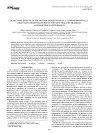Monitoring sublethal effects of pharmaceuticals on nontarget species in aquatic environments has become an important topic in ecotoxicology, yet few studies have been conducted concerning the effects of beta-blockers on aquatic organisms. The present study investigated the effects of the beta-blocker sotalol (SOT) at 3 environmentally relevant concentrations on life-history traits of the New Zealand mudsnail Potamopyrgus antipodarum. Based on the pharmacodynamic properties of SOT, the authors hypothesized reduced numbers of embryos in the brood pouches, decelerated growth of adult snails, and smaller size of neonates, but no effect on mortality rates of adults. Contrary to the hypothesis, the total number of embryos was significantly higher after 56 d of exposure at nominal concentrations of 0.05 µg/L and 1.0 µg/L by 107% and 73%, respectively. No differences in embryo numbers were observed at earlier time-points. Therefore, the mode of action seems to be an extension of the reproductive period rather than an increase of the embryo production. Furthermore, our results indicate a hormetic dose–response relationship, because no effects were observed at the highest test-concentration (6.5 µg/L). Mortality, growth of adult snails, and neonate sizes were not affected by the beta-blocker. Given the strong influence on reproduction, the effects of sublethal concentrations of SOT and other beta-blockers deserve better consideration in ecotoxicological risk assessment.
